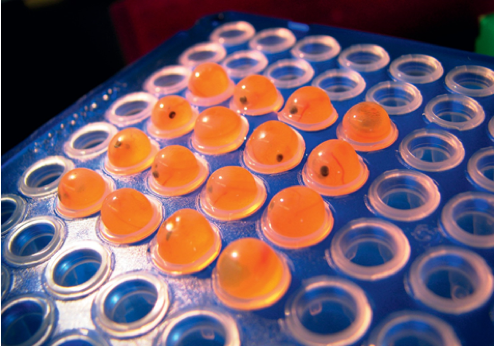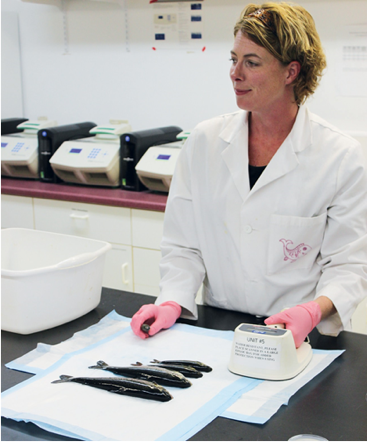Giant Leap
Labeled Frankenfish, the first genetically modified salmon could help feed the world
By Dave Conley, AquaBounty Technologies
(Originally published in Fish Farmer magazine, Volume 33, No. 5, May 2015. www.fishfarmer-magazine.com)
More than 25 years ago, scientists in Canada genetically modified the DNA of a salmon and created a fast growing fish. From this, they have since produced generations of super salmon from a hatchery on Prince Edward Island and a fish farm in Panama.
The fish have yet to win approval from the US Food and Drug Administration but if they do they will become the first genetically modified animals to be used for human consumption. Here, Dave Conley of AquaBounty Technologies, the pioneers behind AquAdvantage Salmon, explains how they got this far.
Can you give an outline of your work – from the first GM fish to how the plant in Panama operates today?
In the mid to late 1980s, researchers at Memorial University of Newfoundland and University of Toronto were collaborating on projects involving Atlantic salmon. One of their ideas was that faster growing Atlantic salmon would shorten the production cycle, reduce risks, and reach market size sooner – something all farmers have been trying to do with crops and livestock for centuries.
By chance, one of the team’s researchers had access to the growth hormone gene from Chinook salmon. Another researcher had identified the DNA sequence from the Ocean pout (Zoarces americanus) that acts like an ‘on-switch’ to regulate the production of antifreeze proteins. A genetic construct comprised of the ‘on-switch’ and the gene that produces growth hormone was microinjected into fertilized eggs of Atlantic salmon.
 The eggs were incubated until hatched and the resulting fry and fingerlings observed for growth. A number of the fish grew much faster than their siblings and when examined were shown to have integrated the construct (transgene) into their genome. The first of the group to reach sexual maturity was a female which became the founder fish for the AquAdvantage Salmon line.
The eggs were incubated until hatched and the resulting fry and fingerlings observed for growth. A number of the fish grew much faster than their siblings and when examined were shown to have integrated the construct (transgene) into their genome. The first of the group to reach sexual maturity was a female which became the founder fish for the AquAdvantage Salmon line.
When grown to market weight, the AquAdvantage Salmon is identical to the conventional Atlantic salmon except that it reaches that size in approximately half the time and consumes 20 percent less food to do so. As a food, the two salmon are identical.
Currently, AquaBounty has a hatchery in Bay Fortune, Prince Edward Island (PEI), Canada and a research grow out facility in the highlands of Panama. Both facilities are used for research purposes; however, the PEI facility has been approved by Environment Canada to produce AquAdvantage Salmon eggs on a commercial scale. Of course, the company is awaiting approval of AquAdvantage Salmon as food before initiating operations.
Since those early days how has the process developed?
Although the initial fish was created in 1989, regulatory development did not start for several years. Part of the reason for the delay was the lack of a clear regulatory path for approval of such a pioneering product. Management and researchers at the company anticipated potential concerns from a variety of sources and built significant mitigation features into the final product proposal.
For example, the company realized the rapid growth phenotype would overcome economic barriers to growth in land-based aquaculture systems. The company then proposed it would grow all female, triploid (sterile) populations in land-based systems. These features address all the substantive objections for any effects on biological diversity or impacts on the environment.
All of the methods for production were validated to assure the integrity of production and document the process. AquAdvantage Salmon will only be farmed in land-based recirculating aquaculture systems (RAS) equipped with multiple barriers to escape. In the 25-year history of the fish, there have been no escapes. At the public meeting in 2010 organized by the FDA, several independent experts pointed out that this was safer for the environment than the contemporary sea pen practice.
Who are the leading characters driving the project?
 The original team included Dr. Garth Fletcher at Memorial University, Dr. Choy Hew, originally at Memorial University but who moved to the University of Toronto, and Dr. Peter L. Davies at Queen’s University. Their work attracted the attention of Elliot Entis, a Boston-based entrepreneur who had developed an interest in antifreeze proteins.
The original team included Dr. Garth Fletcher at Memorial University, Dr. Choy Hew, originally at Memorial University but who moved to the University of Toronto, and Dr. Peter L. Davies at Queen’s University. Their work attracted the attention of Elliot Entis, a Boston-based entrepreneur who had developed an interest in antifreeze proteins.
It was Entis who initiated the work to bring the AquAdvantage Salmon to market by meeting with the FDA in 1994 to discuss the proper path to take. In 1995, the company applied to FDA for approval to sell the eggs and to date is still awaiting approval. It was in 2006, however, that the final product development plan ‘crystallized’ and significant regulatory progress was begun, led (sic) by a team put together by Ron Stotish and John Buchanan.
If given government go-ahead could you produce (and sell) enough to make it commercially viable?
Of course! We would not continue the project if we were not confident of its viability. There will be a period of scale-up and growth (of the salmon), but we are very confident we have an appealing and economically viable product. Since our salmon will be grown in land-based contained systems, our product will be inherently sustainable, with a reduced carbon footprint, lower transportation cost, and better production efficiency. We believe these advantages will help drive adoption and better serve consumer markets around the world.
Is the FDA likely to give its approval to GM salmon this year?
There is no way to predict FDA action. However, we remain hopeful and continue to support a science based regulatory process. As a pioneer, we have been subjected to a great deal of additional scrutiny but are confident in our science and the value of our product.
If so, how quickly can the production process begin?
We will begin our scale-up activities as soon as regulatory approval is received. Even our fish require some time to reach market weight.
If not, can you afford to continue?
AquaBounty has a committed shareholder base which has supported us and will continue to support us. Our majority shareholder is Intrexon Corporation, a leader in the introduction of new technology in the life sciences.
Has the public’s perception shifted at all since you embarked on this long journey?
There is probably a need to distinguish between the ‘public’ and the very noisy opposition groups which have been active over the last few years. Certainly, there is evidence of public acceptance of novel approaches for medicine and food production, particularly in the agricultural sector. There has also been an increase of anti-science and anti-technology activity by opposition groups, which claim to speak for consumers. We believe the most important test of a product is the quality, safety and ultimately the consumer buying experience. On that basis we have confidence we will be very successful.
We do not anticipate any difficulty in finding outlets for our product once it is approved and available.
How soon before we in the UK can taste these salmon?
The company has no plans to produce or sell AquAdvantage Salmon in the UK or EU. Political policies in the EU are not favorable for products such as ours, but if those policies were to change we would naturally be interested in considering those markets.



